A Study on the Evolution of Labor Self-Organizations and the Design of Governmental Mechanism from A Complex Network Perspective
Xu Qingqing, Lu Lan & Liu Pengcheng*
Abstract: Self-organization theory informs an analysis on the evolution of labor self-organizations (LSOs),but lacks technical analysis on the evolution of their organizational structures. Fortunately, complex network technology offers a new approach to analyzing these structures. Built on an extension of the Barabási-Albert (BA) model, we can simulate the evolution of LSOs by analyzing indicators including the clustering coefficient, degree distribution (DD) and average path length (APL) of workers, thereby demonstrating the evolving patterns of LSOs. Accordingly, governmental mechanism designs based on such patterns may not only stimulate energy growth and functional realization of LSOs, but also reduce the social percussions of abrupt evolutions. A comparative analysis of the evolutionary trajectories of LSOs in China and the U.S. finds that the U.S. government's mechanism designs for protecting capitalism not only prevented the effective gathering of workers, but also prolonged the history of industrial conflicts. Such mechanism designs also led to the early dispersion and decline of LSOs and hindered the evolution of the working class. In contrast, the Chinese government established a socialist system that allowed workers to become the underlying force of socialist productivity. This design reduced labor strife while accelerating the evolution of workers towards higher stages.
Keywords: Complex networks (CNs); self-organization; evolution; mechanism design
The evolution of LSOs is a key variable that drives firms to identify direction and an orderly structure from uncertainty and chaos. The spontaneity and disorder of LSOs will directly lead to collective actions beyond what firms can afford, escalating into social conflicts. Therefore, the evolution of LSOs is not merely a central topic of labor economics, but also an area of focus for sociology.
1. Theories on complex networks and LSOs
The science of self-organization, including the dissipative structure theory,①Prigogine, 1969.synergetics,②Haken, 1969.catastrophe theory③Thorn, 1972.and hypercycle theory,④Eigen, 1979.unanimously believes that a system evolves in a way that its components interact and break out of the chaotic state of system development in a process from disorder to order and from lower orders to higher orders. Built on self-organization theories, the evolution of labor self-organizations(LSOs) is also a highly uncertain process from chaos to order and from low organizational levels to higher levels. Self-organization theories have been widely applied to labor economics. Robert et al., based on their research on the evolution of LSOs and the division of labor, hold that an LSO is a potential biosystem and division of labor is a self-organizing attribute of complex systems.⑤Robert et al., 1998They analyzed, given natural selection,how to operate such a complex system, giving rise to the evolution of the division of labor.⑥Robert, Sandra, &Mitchell, 1998.Tabata et al. used a master equation, i.e., a nonlinear population differential equation, to study labor mobility caused by regional economic gaps, thereby leading to the evolution of self-organizations.⑦Tabata et al., 2001Such an equation is mainly dictated by a dominant parameter which, if below a critical constant (1/2), would drive an LSO to a unique asymptotically stable equilibrium, but if greater than the constant, would cause the LSO to move toward an infinitely unstable equilibrium and assume the features of increasing structural collapse over time.⑧Tabata, Eshima, Takagi, 2001.
Though self-organization theories have revealed how such systems evolve and where they end from a macroscopic perspective and illustrated the structures of self-organizations with graphs and matrices, they have offered little technical analysis on intra-organizational structures. Complex network technology provides such an analysis on structural evolution with a new approach. To date, the latest studies on complex networks focus on the co-evolution of individual attributes and strategies such as “node properties,” “l(fā)ong-distance edges,” “node migration” and “broken edge rewiring,” with network structures. Klein, building on social exchange and similarity-attraction theories, concluded that values and personality will decide if a node can secure a central position.⑨Klein, Lim, Saltz & Mayer, 2004.Kilduff et al. described the complexity and uniqueness of individuals and analyzed the dynamic co-evolution processes of individuals and networks.⑩Martin, Wenpin & Ralph, 2006.Tommy et al. analyzed how and to what extent the scope of edge rewiring affects cooperation, and concluded that a global version of this exercise would better facilitate the evolution of cooperation than a local one.?Tommy, Feng & Scott, 2016.Abranmson, Kuperman compared how the prisoner's dilemma gives rise to emergence of cooperation on two different networks, i.e., regular lattices and random networks, and analyzed the relationships between the probability of broken edge rewiring and the extent to which cooperation emerges.①Abramson & Kuperman, 2001.Zimmermann et al. introduced the broken edge rewiring mechanism for local neighborhoods into adaptive network dynamics, and demonstrated that this mechanism may enable networks to assume small world characteristics, and that high-degree nodes play a dominant role in network stability.②Zimmermann, Eguíluz & San,2004.Yang, Wu, et al. studied expectation-driven node migration mechanisms and concluded that, when a node has interacted with all immediate neighbors, if its expectations were not met, then it would tend to leave and migrate to another physical location where it could explore, and that expectation-based migration greatly promotes cooperation.③Wu et al., 2012.
According to complex network technology, we can interpret an LSO as a system comprised of complex networks of relationships on which nodes represent individuals and edges represent connections with each other, while the evolution of LSOs may be described by a complex network model. The research on the structure and evolution of LSOs helps avoid the damage to society caused by the disorder created by its evolution and provides governments with operable means and methods to guide the evolution of LSOs.
2. Theoretic analysis on the evolution of LSOs and governmental mechanism designs
2.1 Evolution of LSOs
Capitalist production is a process of separation of workers from the means of production where workers are thrown into the market. So, we view atomized individual workers as the starting point of LSOs. According to the evolving patterns of self-organizations, this paper breaks down the evolutionary process of LSOs into five stages: low self-organizing degree, high self-organizing degree, complex self-organization, loose and dying self-organization, and networking of individual workers.
At the first stage, workers would randomly wire within a range of physical proximity, but due to the randomness and uncertainty of this edge wiring, their self-organizing degree is low under a loose network structure.④Xu, 2015.At the second stage, the emergence of worker central nodes increases information exchange between workers, enabling more stable wiring between workers, greater clustering coefficient of LSOs,an elevated self-organizing degree and a bigger network. At this point, the employer may prevent workers'connections, or break or buy in central nodes. These actions would directly trigger labor-management conflicts. Such group conflicts may escalate into social conflicts. At this stage, “catastrophe” evolution incidents like workers' revolutions may arise.⑤Xu & Lu, 2017.At the third stage, LSOs will grow more complex, as workers'wiring tends to be fixed and network size reaches a peak. Technological development enables faster migration of labor nodes and a greater range of wiring. Long-distance edges push the limits of path lengths and area constraints between nodes, giving LSOs small world characteristics. “Merit-based wiring” mechanisms enable the tendency of new nodes to first wire with nodes with wider distribution. Power law distribution makes LSOs scale-free. The increasing return effect of wiring drives fixed, normalized wiring between workers. As LSOs proceed to a higher degree, divisions of labor will be clearer, and headcounts of LSOs will reach their peak. At this stage, workers and management would try to solve labor conflicts through collective bargaining, and group conflicts will reduced. At the fourth stage, LSOs will become loose, and their network structures will deteriorate. At this point, IT development offers technical support to compliment organizational structures and intra-organizational order and rules and structures will start a restructuring process. Senior workers will evolve out of trade unions to form trade associations, while LSOs will become more divided and loosely structured, and worker cooperation over networks will go beyond corporate boundaries, leading to more socialized production. However, capitalists still hold key networks of productive resources, sowing the seeds for institutional changes. At the fifth stage, LSOs will disappear, and workers will be connected on a non-clustered basis. In the future, no intermediary nodes will be needed as bridges, and businesses, markets and LSOs, will finally disappear. As labor collaboration of socialized mass production blurs wiring based on material benefits and enhances workers' prosociality, workers will be infinitely wired together on a nonlinear basis. Thus, the working class will be catapulted from a “class in itself” to a “class for itself.”
2.2 Simulation test on the evolution of LSOs
Based on an extension of the BA model, this paper analyzes a range of measures such as the clustering coefficient, degree distribution and APL of workers (nodes) to simulate the evolutionary path of LSOs. The model assumes that in the evolutionary process of LSOs, as new labor nodes join in, the size of networks would increase over time; the attachments between workers has its preference, but does not fully conform to the degree-preferential attachment principle; new entrants are also very likely to attach to low-degree workers.Therefore, the probability (∏i) of a new entrant attaching to incumbent worker i within a self-organization would be
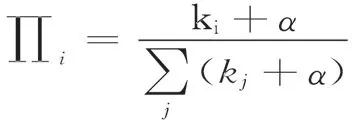
Where α>0, and in this case, α=1. The model assumes that all connections of the relationship network of workers in a cluster are equally weighted, i.e., the strength of relationships between workers is not factored in. In constructing model evolution, we start with two labor nodes initially, then add one node at a time, and continue until 1,000 nodes have been included.
(1) Clustering coefficient (C)
A clustering coefficient represents the grouping degree of clusters, i.e., characteristics of small groups.Assume a random node i in a network has kineighbors. Without automated and repeated attachment, there are at most ki(ki- 1)/2 edges between kinodes. In fact, there will be Eiedges between these kinodes. Then, the clustering coefficient Ciof node i would be

The clustering coefficient C of the entire network is the average of clustering coefficients of all nodes in the network.

The simulation results show that clustering coefficients of nodes are primarily distributed around point zero (Fig. 1), indicating that the majority of workers have no cohesion to form small groups, and the selforganization is loosely structured. Only a very few nodes have great clustering coefficients, suggesting that only a minority of workers have the cohesion to form small groups. The fact that a few workers have greater Cs is probably due to the inherent qualities of the workers. For example, they have better access to information so that they can more easily wire with adjacent workers, or these workers themselves are “bold” or “daring,”willing to lead others to seek group interests.
As new workers join in, the clustering coefficient of an LSO network become greater, and clustering characteristics grow more obvious. This is generally reflected in the big size of a single group or a large number of clusters within a group, but the clustering coefficient of the network as a whole will not continue to increase. At a certain point, the clustering coefficient of an LSO will start to drop, with weaker clustering and a looser structure.
(2) Degree distribution (DD)
The degree of node i, i.e., ki, represents the number of nodes directly connected with this node. Distribution function P(k) represents the probability of the degree of a randomly selected node being exactly k. P(k)describes the degree distribution of a node in a network, and is used to measure the extent of the information exchange between workers, i.e.,

Simulation results reveal that the degree distribution of LSOs complies with the power law profile (Fig. 3).This means that there are less channels for wiring and information exchange between most workers as only a very few have greater access to these activities. This fits with the power law distribution because high-degreelabor nodes possess richer information, so attachment with high-degree nodes is more likely to obtain more information. As a result, more workers can easily establish connections through high-degree nodes.
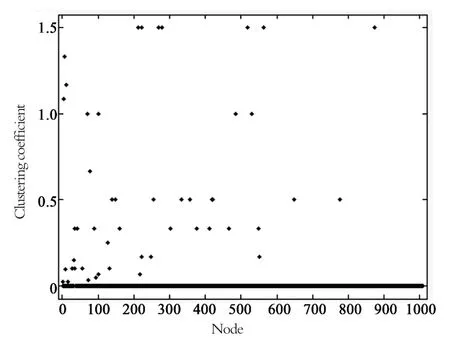
Fig. 1 Clustering coefficients of labor nodes
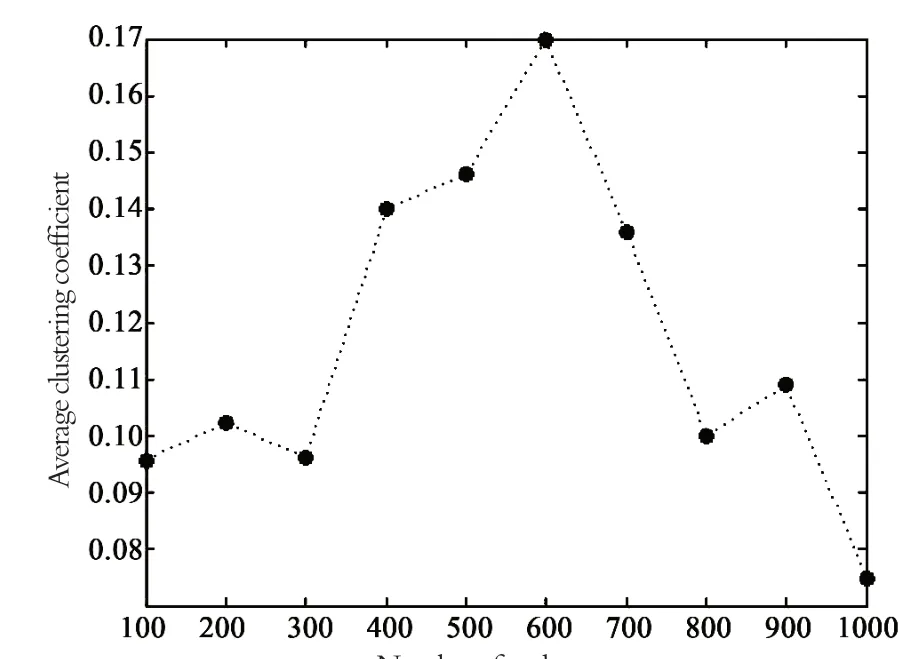
Fig. 2 Average clustering coefficients of entire network
(3) Average path length (APL)
The distance between any two nodes i and j (dij) is defined as the minimum edges that must be run through in order to connect these two nodes. N denotes the total number of network nodes. Regardless of the distance from a node to itself, the average path length (L) of the entire network is defined as the average of distances between all nodes, i.e.,

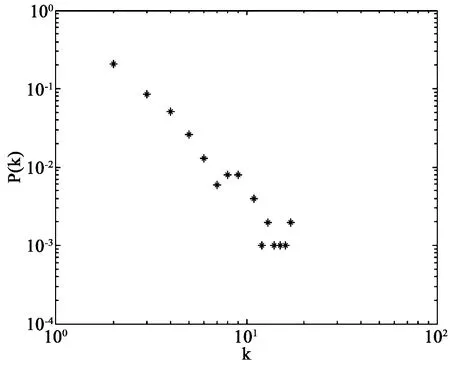
Fig. 3 Degree distribution of LSOs
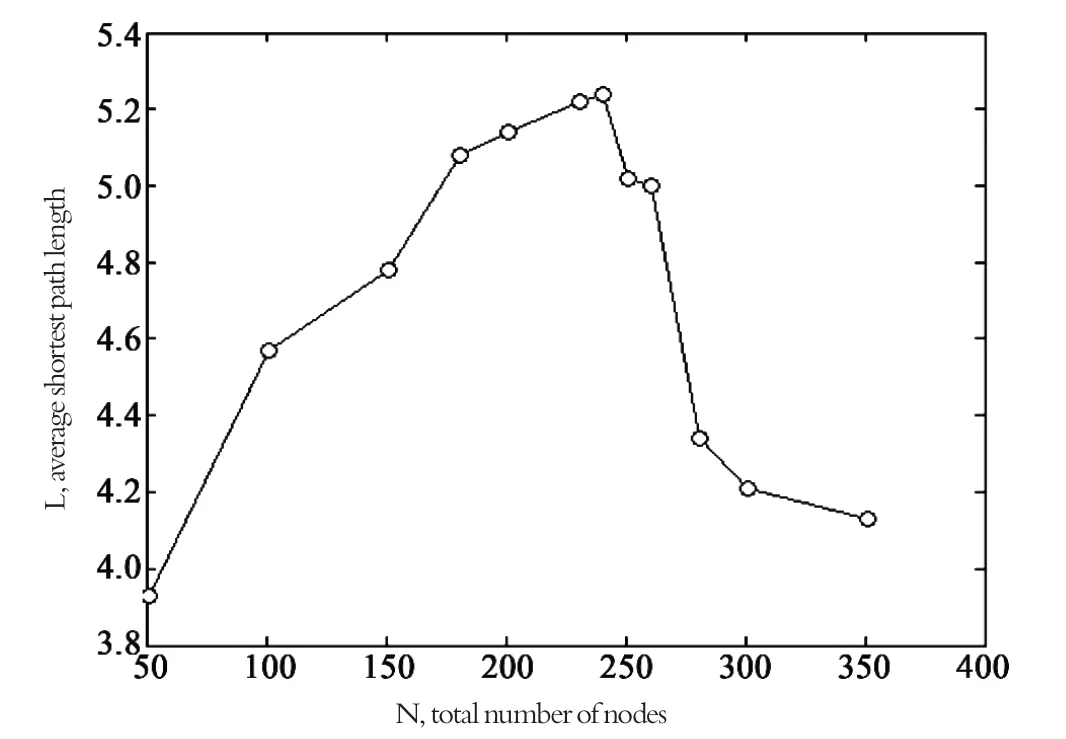
Fig. 4 The shortest APLs of LSOs
The average path length L of an LSO network, to an extent, measures the attachment cost between workers. The longer the path, the higher the attachment cost. Conversely, the shorter the path, the lower the attachment cost. The APL goes through a process of increasing before declining (Fig. 4), because when there is a small number of nodes, the search and attachment cost of workers is high due to the great APL; while when a central node emerges, many workers will connect through such central nodes, greatly reducing the APL of the entire network. Thanks to the scalability and “merit-based wiring” mechanisms of networks, such central nodes will over time evolve into high-degree nodes. Connections with such high-degree nodes can boost the chances of acquiring information.
LSOs will go through a gradual process from turmoil towards stability (Fig. 5). At the early stages of LSOs,networks are in disarray. The lack of mutual understanding prompts random wiring between workers, with few nodes connected and low clustering coefficients. As LSOs grow and mature, shared interests glue together value judgments of workers and as a few “central nodes” bridge information flows, connections between workers sharply increase to form relatively stable circles of exchange, along with higher clustering coefficients.However, when the headcount in an LSO increases to a certain point, quantity-driven structural and qualitative changes will grow much slower. Finally, as self-organizations decline, thanks to lowered attachment cost for workers driven by technological development, central nodes are no longer needed to establish connections. This will lead to smaller clustering coefficients, weaker network clusterings, and looser organizational structures.①Tan & He, 2009.
2.3 Governmental mechanism designs
As LSOs differ with general self-organizations, the disorder and uncertain “catastrophes” in its evolutionary process may cause societal regression. To reduce the damage of LSOs along their evolutionary paths, an inquiry into the role of government in this process is required. As the evolution of LSOs is a process dependent on spontaneous behaviors of micro-agents, whether governmental mechanism designs can facilitate the complex, adaptive and systemic evolution of LSOs towards higher stages depends on whether governments follow their evolving patterns, and if governments can stimulate the tensions and potential within these organizations to affect their structures, directions and trajectories.
First, governments may intervene on the increase and decrease of labor nodes.Governments control the number of labor nodes through birth control, pro-childbirth, immigration and other measures. Second, governments can increase long-distance edge connections between labor nodes. Governments can accelerate the mobility of workers by encouraging technological innovation, to push the area limits on edge connections. Long-distance edges not only drive “spatial structure” changes in labor networks, but also enable the clustering of workers within a wider range. Third, governments can guide the broken edge rewiring of labor nodes. Governments can normalize workers' rights to connections. Broken edge rewiring mechanisms may be used to step up the chances of disconnections between workers and defectors, and guide workers to wire together correctly to shape labor networks centered on high-degree nodes. Finally, governments can guide the migration of nodes.As the industrial relocation of workers drove industrialization, and the spatial relocation of workers shaped urbanization, governments can, considering industrial goals and urbanization programs, guide the migration of workers thereby accelerating economic upgrading.
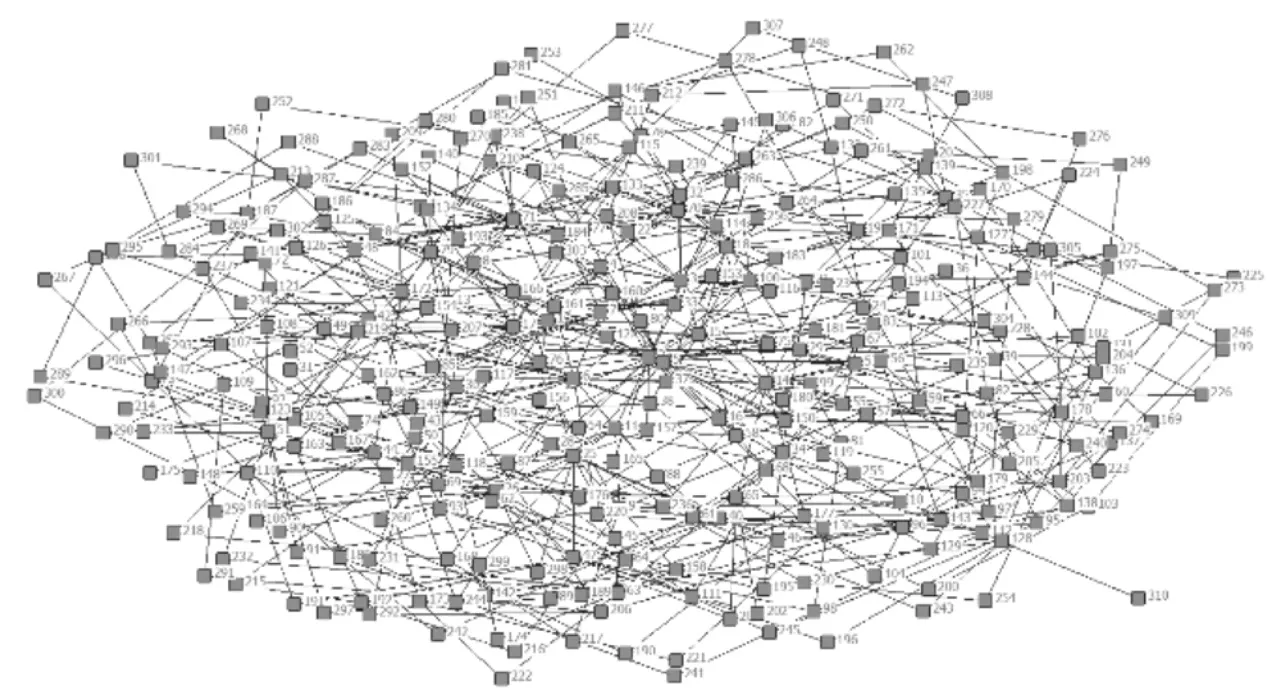
Fig. 5 Evolving structures of LSOs
3. Empirical research: China vs. the U.S.
With the U.S. and China selected as the sample for studying the evolution of LSOs, this paper looks at the degree of fit of the evolutionary paths of LSOs with computer simulated results to demonstrate the evolutionary patterns of LSOs. Also, by comparing the evolutionary paths of LSOs in China and the U.S., this paper analyzes the role of governmental mechanism designs in this evolutionary process.
3.1 Evolution of LSOs and related g o v e r n m e n t a l mechanism designs in the U.S.
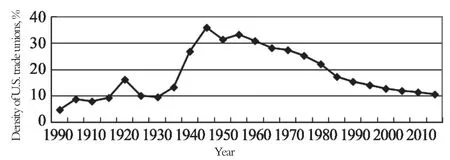
Fig. 6 Changes in the density of U.S. trade unions

Fig. 7 Number of strikes and strikers involved in U.S. (1926-1949)
3.1.1 Evolution of U.S. LSOs
U.S. LSOs (trade unions) followed the patterns of evolution f r o m l o w s e l forganizing degree to higher degrees and finally a loosely organized state (Fig.6). From an historic view, the density of trade unions in the U.S. stood at 4.9% in 1900, 35.8% in 1945 and 10.7% in 2014.Throughout the U.S.history, trade unions went through four evolutionary stages as self-organizations.The first two stages featured intensifying labor group conflicts,while into the third stage, these conflicts started to decrease. In 1926, there were 1,035 strikes in the U.S., involving 330,000 workers; in 1946, there were 4,985 strikes involving 4.6 million workers, recording a peak level (Fig. 7), along with trade unions rising as strong economic organizations. By the fourth sage, particularly the 1980s, labor conflicts rapidly declined, and group stoppages (involving 1,000 workers or more) sharply decreased from 424 incidents involving 1,698,000 workers in 1950 to 12 involving 47,000 workers in 2015 (Fig. 8). Meanwhile,trade unions diverged structurally, with their numbers in continuing decline from 35.8% in 1945 to 10.7% in 2014.
3.1.2 U.S. governmental mechanism designs
During the first evolutionary stage of LSOs (late 18th Century to mid-19th Century), as the U.S.government deemed strikes aiming at higher wages and better working conditions as crimes, trade unionsfailed to attract workers with such benefits. This led to u ncer taint y i n w o r k e r s'connections and low degrees of self-organizing.During the second stage (mid-19th Century to early 20th Century), as workers' clustering scale stabilized and self-organizations expa nde d, t he g o v e r n m e n t generally imposed labor injunctions to ban various types of strikes. This approach backfired and exacerbated the scale, frequency and duration of labor conflicts, ending up creating a more unified front, i.e., national trade unions.①William, B., Gould, A Primer on American Labor Law, Cambridge: The Massachusetts Institute of Technology, 1982, pp. 12-19.
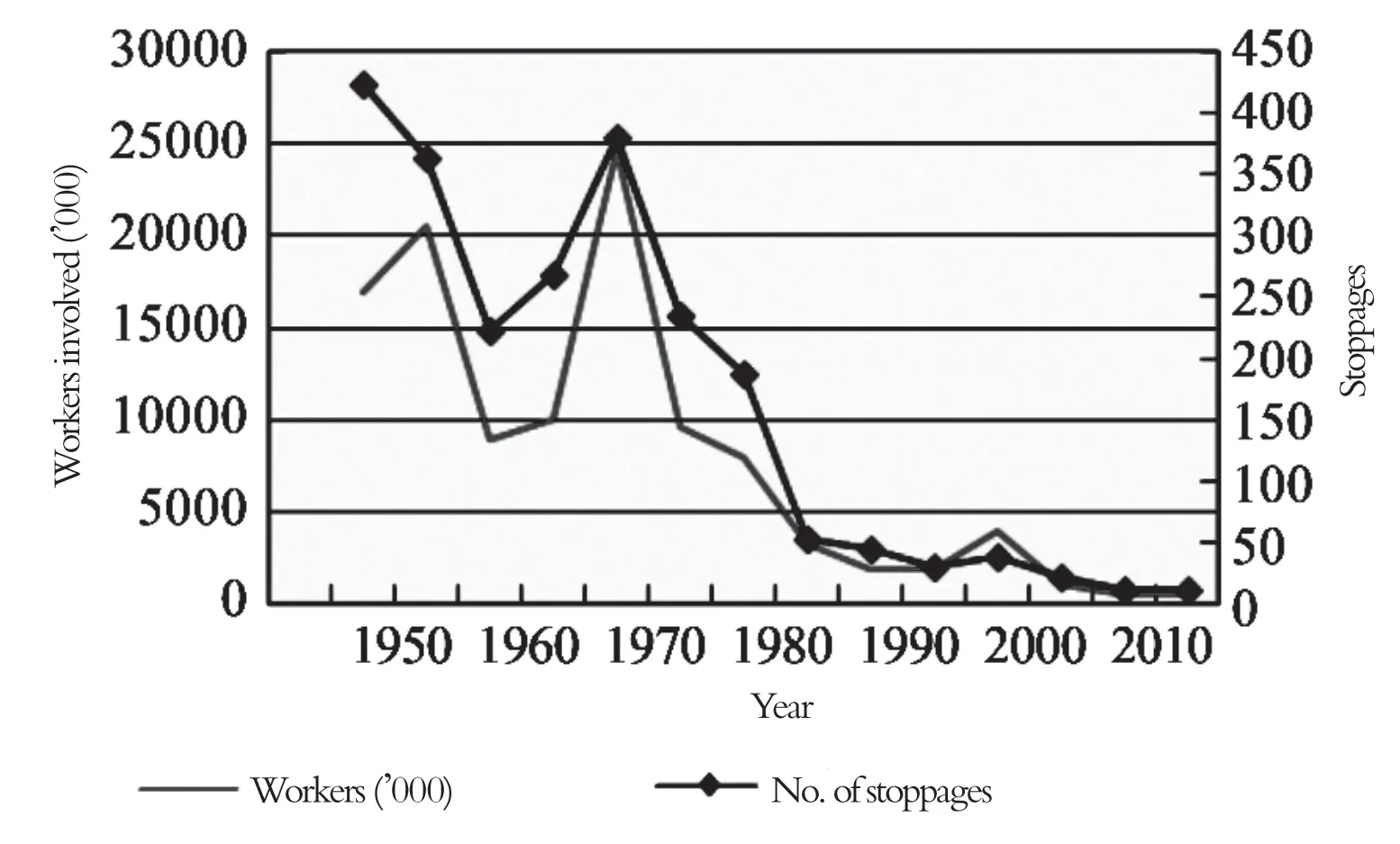
Fig. 8 Number of worker stoppages(above 1,000 workers involved) and workers involved in the U.S. (1950-2015)
At this stage, the government's intervention in LSOs not only postponed balanced labor relations, but also prolonged the history of labor conflicts. By the third stage of LSOs (the 1930s to the 1970s), as the strong force of clustered workers forced some capitalists to turn to collective bargaining with workers, a bottomup change pushed the adjustment of government mechanisms dealing with industrial relations. The National Industrial Recovery Act of 1933 and the National Labor Relations Act of 1935 empowered trade unions' rights to strike and collective bargaining, enabling disadvantaged workers to counterbalance employers by leveraging their collective power. As workers stepped up their connections and clustering, there was a surge in unionized workers, leading to an increasing density of trade unions from 13.4% in 1935 to 35.8% in 1945, a peak of U.S. trade unions. The Taft-Hartley Act of 1947, also known as the Labor Management Relations Act, imposed provisions to split up LSOs to curb the expansion of trade unions. Such measures not just prolonged the history of labor group conflicts, but also led to the early divide and decline of LSOs. Into the fourth evolutionary stage(1980s to present), the early decline of LSOs impeded these organizations to lead institutional changes.
3.2 Evolution of LSOs and mechanism designs with Chinese characteristics
In a complex international labor environment, to build a Socialist system on backward productivity, the Chinese governmental mechanism designs regarding LSOs had a clear logic, accompanying an evolutionary path of LSOs with distinct Chinese characteristics.
3.2.1 Evolution path of LSOs with Chinese characteristics
During the first stage, i.e., prior to the founding of the PRC, the invasion and exploitation of foreign capital on Chinese workers triggered the “catastrophe” evolution of workers. Capitalist invasions led to the emergence of central worker nodes with clustering effects. These nodes, as carriers of information and leaders,glued together many workers and enabled the rapid growth of LSOs. In the revolutionary struggle led by the Communist Party of China, connections between workers grew more stable and organizations more orderly.Finally, the CPC led workers to take power, ending the “catastrophe” evolution of the labor-management system, and charted an evolutionary path of LSOs only seen in China.
The second stage featured the shift from planned trade unions in the planned economy era to wiring of labor nodes reshaped by market mechanisms. In the planned economy era, trade unions were not workers organizations against employers, instead they were workers organizations organized and coordinated by the government to build Socialism on a top-down basis. Government's direct allocations of the urban workforce and guiding the migration of rural labors as peasant-workers paved the way for shaping China's full-range industrial system as a priority. With the establishment of a market economy and reform and opening-up, the Chinese economy released enormous productivity and the position of labor as the main production factor for seeking profits was established. The marketization of China's labor relations began. First, the dissolution of existing entities and bankruptcy of state-owned enterprises (SOEs) led to the removal or consolidation of existing trade unions, along with a disconnection between workers. Second, as workers found new jobs, mostly in non-state sectors, and LSOs were not simultaneously established in such non-state sectors,the development of trade unions hit a low in 1999 when there were 509,000 grassroots trade unions with 86,899,000 members nationwide by year end, down by 96,000 organizations compared with that in 1995, or a decrease of 17,097,000 unionized workers (Fig. 8). To overcome difficulties in forming LSOs in non-state sectors, the government started a top-down approach to organizing trade unions and empowered workers with rights to collective bargaining (Fig. 9).

Fig. 9 Numbers of government-organized grassroots trade unions and unionized workers
At the current third stage, the evolution of Chinese LSOs combines the features of multiple stages. Since the 18th CPC National Congress, Chinese government's top design for labor systems has given China's LSOs multistage, leap-frogging characteristics. The government started to implement a “collective bargaining”system that effectively pools Chinese workers, which enabled LSOs to show some characteristics of the third evolutionary stage over time. The adoption of “network plus trade union” approach has led to a flattening structure of trade unions, a structural feature of LSOs at the fourth stage. The advocacy of Socialist labor values, “craftsmanship” and “entrepreneurship,” coupled with strengthening the role of mental giveback mechanisms in the connections between workers, have laid the foundation for the working class' elevation from a “class in itself” to a “class for itself,” a characteristic of the fifth stage.
3.2.2 Chinese governmental mechanism designs
The Chinese government, following the evolutionary patterns of LSOs, has based its governance on the changes and needs of the working class, thus stimulating the energy growth and functional realization of LSOs.
First, facilitating the growth of the workforce. Facing the slowdown in the natural generating rate of workers, the second child policy effectively increases the workforce, providing impetus to the sustainable development of the labor system. It is suggested that birth control be fully lifted, and tax cuts be linked to new family members so that household-based combined tax rates stimulate the growth of the workforce.
Second, reducing the cost of connections between workers. The development of network information technologies and the transmission of regular information help create a favorable environment for wiring between workers. The promotion of traditional Chinese culture, Socialist labor values and a cohesive workforce built on common beliefs not only cut the cost of node wiring, but also prompt workers' shift from seeking personal gains to seeking benefits for a majority of people by acting collectively.
Third, strengthening the self-discipline of trade unions and channeling the orderly clustering of workers.Facing the collapse of existing labor structures caused by the exit of foreign-invested enterprises (FIEs), selfdiscipline of trade unions is being encouraged, orderly dissemination of public opinion is being facilitated and“implementation rules of collective bargaining” are being developed on a tailored basis to guide the rounds and processes of labor negotiations in an orderly manner, and prevent the escalation of strikes into societal conflicts.
Fourth, guiding the orderly migration of workers into cities and actively developing the rural revitalization strategy to prevent the collapse of existing agricultural and rural structures. As new generations of migrant workers completely abandon farming, existing rural network structures are starting to see reduced nodes and edges. Therefore, while channeling capital to rural areas and agriculture, it is important to properly run land transfer and large-scale agricultural operations which are key to establishing a new agricultural network structure. At the same time, the government is working to provide professional training to new-generation migrant workers and develop mechanisms to encourage them to pursue continued education to guide these new-generation migrant workers to connect with capital in urban spaces in an orderly manner.
Fifth, guiding labor cooperation. Following the concept of innovative, coordinated, green, open and shared development, the government promotes labor cooperation and innovation, coordinates the flow of labor across regions and spaces, establishes new green, harmonious labor relations, develops higher-level open economies,facilitates and creates communities of shared labor interests across the world, and sticks to shared development for all workers. Also, the government is initiating further supply side reforms to optimize the spatial allocation structure of labor as a production factor and widely facilitate labor cooperation to increase effective supply.
4. Conclusion
The evolutionary patterns of LSOs from disorder to order and on to a loose state and disappearance have a role to play in social evolution. Though governmental mechanism designs cannot go beyond this law, it can plan different evolutionary paths.
Governmental mechanism designs, if they go against the evolutionary patterns of LSOs, not only prolong labor conflicts, but also hinder social evolution. For example, the U.S. government mechanism designs during the first and second stages of LSO evolution, which hampered workers' connections, led to a protracted history of labor group conflicts, and during the third stage a governmental mechanism that split many LSOs caused the early decline of these organizations and blurred the goals of the working class fighting for shared interests, thus hindering social evolution. As a result, U.S. LSOs came across a qualitative problem in pushing ahead social evolution.
In contrast, governmental mechanism designs, if compliant with the evolutionary patterns of LSOs,not only reduce the damage of labor conflicts to society, but also accelerate the balance of labor relations and facilitate labor cooperation. With the foundation for spanning the natural evolutionary stages of LSOs,Chinese socialist labor relations depend on governmental mechanism designs for nurture. Therefore, Chinese governmental mechanism designs have been able to stimulate and guide the evolution of LSOs. They can reduce labor conflicts along the natural revolutionary path by balancing labor relations during the first and second stages, accelerating the entry into a balanced, cooperation-as-normal labor equilibrium stage, and quickly realizing spatial and structural optimization of labor cooperation during the third and fourth stages.Governmental mechanism designs can also push the shift from workers' wiring based on reward/return to one based on mental giveback, speeding the lift of workers from a “class in itself” to a “class for itself.”
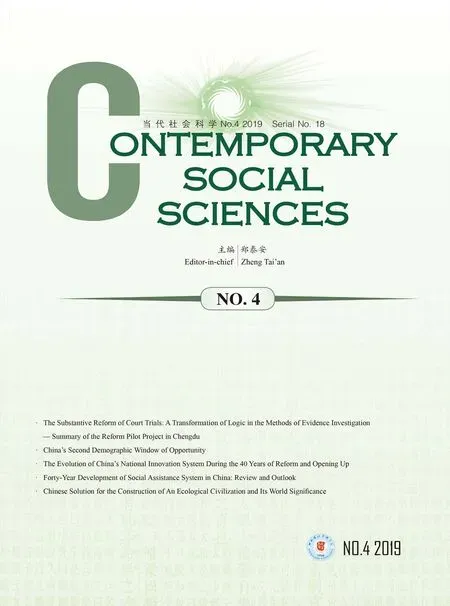 Contemporary Social Sciences2019年4期
Contemporary Social Sciences2019年4期
- Contemporary Social Sciences的其它文章
- An Inquiry into the Approach to Asian Regional Trade Integration Under the Belt and Road Initiative— The Case of the Alignment of a China-Japan-South Korea Free Trade Area
- A Study on Status Assessment and Path Optimization for China-Africa Anti-poverty Cooperation
- China's Second Demographic Window of Opportunity
- Chinese Solution for the Construction of An Ecological Civilization and Its World Significance
- Forty-Year Development of Social Assistance System in China: Review and Outlook
- A Brief Introduction to the English Periodical of Contemporary Social Sciences
